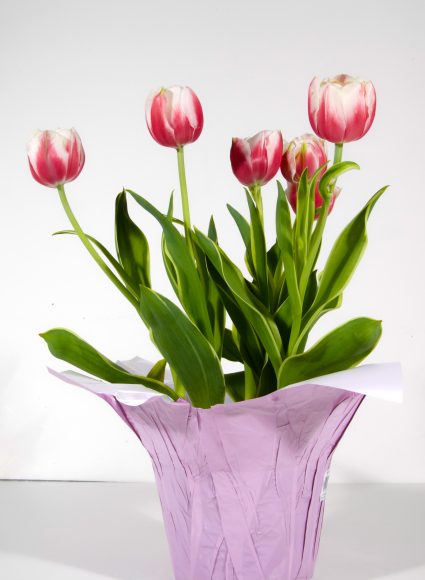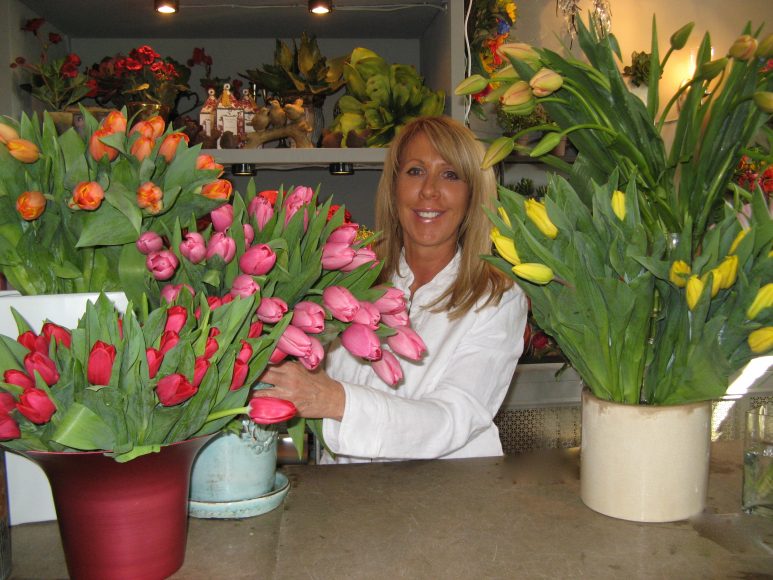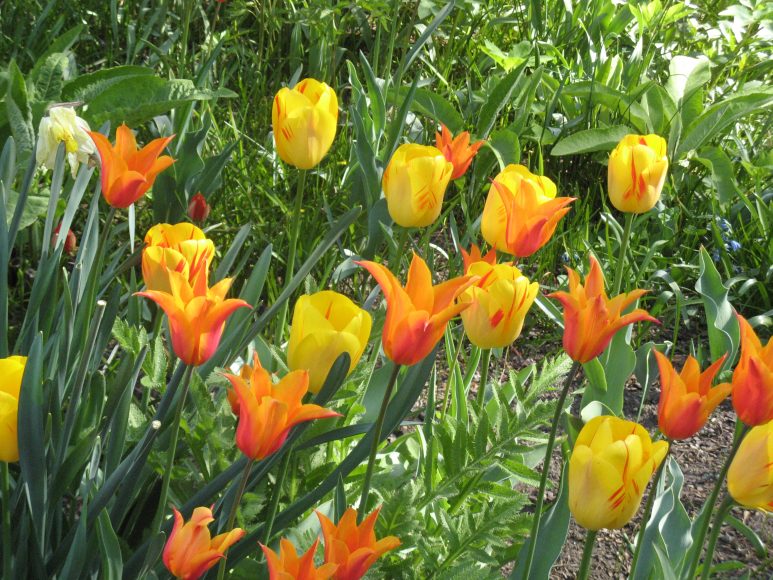I love flowers and tulips are among my favorite. I photograph them, paint them and enjoy them in my home and garden. My fondness blossomed when I lived in the Netherlands some 25 year ago. Flowers are a big business in the Netherlands and you can find them all over. How lucky was I to go to the market every Tuesday or Saturday in the heart of Rotterdam where I lived and gather an armful of tulips for 20 guilders ($10) or so.
Living in the Netherlands intensified my fascination with this flower and I could never get enough of them. I drove through the Dutch countryside to see the striped fields of brilliantly colored tulips and visited Keukenhof, the world’s largest flower garden, where tulips abound.
The Dutch love their flowers too, especially tulips. At one point in history they were crazy about tulips to a point of frenzy. They called it tulipomania, a widespread obsession with tulips, especially the highly prized varieties of unusual color and variegation. Tulipomania raged in Holland from 1634 to 1637 during the country’s golden age. It was the first economic bubble and futures market as men traded bulbs like they would trade commodities today. How was it possible that a single bulb could be exchanged for a sum that would have purchased a town house in the finest quarter of Amsterdam? But it did. And for the practical Dutch it is a mystery why a single flower caused such uproar.
Quite simply this imported luxury, a wildflower of the Asian steppes, could be easily transported and reproduced ad infinitum. Highly prized varieties, such as the Semper Augustus with its flame and striped blooms, were offered for a bride’s dowry besides being traded like stocks.
The tulip had a unique trick that added to its attraction. A plain colored flower might appear the following spring with feathered pedals and delicate, flamed patterns. Little did these 17th century tulip fanciers know a virus caused it. Eventually, the market for tulip bulbs flooded, there was a panic, and the market crashed. This mania has puzzled historians and economists ever since.
The Dutch were not the first to go crazy over the tulip. The bulb enchanted the Persians in the 10th century and was the symbol of abundance and indulgence during the Ottoman Empire. But tulips found their most fertile ground in Holland, first blooming there in the late 1500s when they were imported from Turkey. Golden Age artists like Jakob Marell were summoned to paint watercolors and created catalogs of the coveted blooms. Other artists from Jan van Huysum, the master of Dutch flower painting, to Vincent van Gogh and Claude Monet painted this simple yet elegant flower.
Much has also been written about tulips and the craze they created. Garden expert Anna Pavord wrote “The Tulip,” a definitive nonfiction work about the flower that made men mad. Then there are the romantic historical novels, “The Black Tulip” by Alexandre Dumas and Deborah Moggach’s international bestseller, “Tulip Fever,” both set in the 1700s.
This love of tulips came along with the Dutch when they settled in New York, originally named New Amsterdam, and Holland, Mich., where the connection to the Netherlands is strong. You can see more than 100,000 tulips this Mother’s Day weekend in Albany at the annual Tulip Festival that celebrates the city as the oldest Dutch settlement in America. The United States imports three billion tulip bulbs a year.
“Nothing says spring more than a bunch of tulips!” notes Beth Kuck-Hundgen, who owns Whispering Pines of Chappaqua, where tulips are popular. “Everyone wants to see spring after a long winter.” Tulips happen to be one of Kuck-Hundgen’s favorite flowers, too. “They have a seven-to-10 day shelf life and are not an expensive flower. And they come in a wide range of colors.” Kuck-Hundgen sells a variety of types of tulips. “I love the single tulips and most people buy them. The doubles and parrots are also a favorite.” She buys her tulips from a local grower in New Jersey that she feels has superior tulips. “They grow only the best varieties. Their tulips are very strong and have large heads.” When they are no longer in season locally, she can source them from the Netherlands.
Simple tulips in a simple vase are my favorite way to arrange them and Kuck-Hundgen seems to agree.
“I prefer them to be displayed in mass using all the same color. Tulips continue to grow after cutting so if you like yours nice and orderly a tall narrow vase would be your choice. I myself prefer a freer spirited tulip and will use whatever container complements the flower and occasion.”
Kuck-Hundgen has some practical advice: “Do not put tulips in the same vase as narcissi (the daffodil family). They give off sap that adversely affects the shelf life of the tulip.” And she adds that because tulips are phototropic, keep them in a cooler spot in your home away from direct sunlight. Here’s a tip I learned from a Dutch flower merchant for keeping your tulips lasting longer. Trim the stem at the bottom and cut an “X.” This gives the bloom a better drink of water.
Tulips are everywhere in the spring. Enjoy them as you stroll down Park Avenue in Manhattan or on the grounds of The New York Botanical Garden in the Bronx where you can see the closest thing to the wild tulips that incited the 1630s’ craze.
“We have 60 varieties of tulips planted this year in the Perennial Garden, Seasonal Walk, Home Gardening Center’s Cutting Garden and in pots around the grounds,” says Kristin Schleiter, associate vice president for outdoor gardens and senior curator of herbaceous collections at The Botanical Garden, where tulips are in bloom from late April through early May. “And there are three kinds of species tulips in the Rock Garden that are more like the ones that first grew in the wild. They tend to be shorter so they are perfect scale for the Rock Garden.”
Schleiter says that planted tulips – as opposed to cut bulbs – do best in a sunny, well-drained spot. In our area of the Northeast, deer feast on tulips so Schleiter shares a trick from Dutch landscape designer Jacqueline van der Kloet: “Interplant tulips with daffodils since they are deer resistant and you have a shot.”
For me, the tulip will forever be an irresistible flower that brings back fond memories. When in doubt, a bright bunch of tulips is always the perfect bouquet to send or receive.
After a recent fire, Whispering Pines of Chappaqua has moved to a temporary location, 83 S. Greeley Ave., in Chappaqua. For more information, call 914-238-5661.







